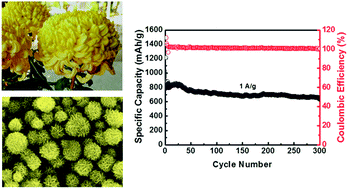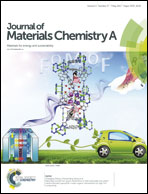A hierarchical α-MoC1−x hybrid nanostructure for lithium-ion storage†
Abstract
Transition metal carbides are promising electrode materials for electrochemical energy storage, yet to unveil their full potential requires judicious structural engineering at the nanoscale. In this study, we report a chrysanthemum-inspired nanoscale design to prepare a three-dimensional hierarchical molybdenum carbide hybrid. It consisted of an ensemble of numerous nanoflakes protruding out from the center, each formed by ultra-small (∼2 nm) α-MoC1−x nanoparticles uniformly supported on a N-doped carbonaceous support. Such a hybrid material has enlarged surface areas, shortened ionic diffusion length, great mechanical robustness, and buffer room for electrode volume change. Owing to the three-dimensional hierarchical arrangement, this hybrid material exhibits impressive performance toward active lithium-ion storage. It delivers a large reversible capacity of >1000 mA h g−1, great rate capacity with significant capacity at 10 A g−1, and excellent cycling stability with >95% capacity retention after 100 cycles at 500 mA g−1. Most impressively, we demonstrate that the structural integrity of the hybrid microflower is largely preserved even after prolonged cycling.



 Please wait while we load your content...
Please wait while we load your content...